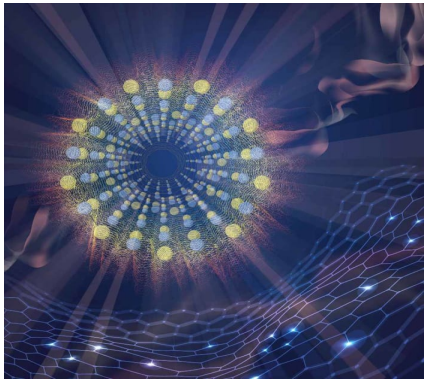The gas turbines powering aircraft engines rely on ceramic coatings that ensure structural stability at high temperatures. But these coatings don’t control heat radiation, limiting the performance of the engine.
Researchers at Purdue University have engineered ceramic “nanotubes” that behave as thermal antennas, offering control over the spectrum and direction of high-temperature heat radiation.
The work is published in Nano Letters, a journal by the American Chemical Society. An illustration of the ceramic nanotubes will be featured as the journal’s supplementary cover in a forthcoming issue.
“By controlling radiation at these high temperatures, we can increase the lifetime of the coating. The performance of the engine would also increase because it could be kept hotter with more isolation for longer periods of time,” said Zubin Jacob, an associate professor of electrical and computer engineering at Purdue. The work is part of a larger search in the field for a wide range of materials that can withstand higher temperatures. In 2016, Jacob’s team developed a thermal “metamaterial” – made of tungsten and hafnium oxide – that controls heat radiation with the intention of improving how waste heat is harvested from power plants and factories.
A new class of ceramics would expand on ways to more efficiently use heat radiation. Jacob’s team, in collaboration with Purdue professors Luna Lu and Tongcang Li, built nanotubes out of an emerging ceramic material called boron nitride, known for its high thermal stability. These boron nitride nanotubes control radiation through oscillations of light and matter, called polaritons, inside the ceramic material. High temperatures excite the polaritons, which the nanotubes – as antennas – then couple efficiently to outgoing heat radiation.
The antennas could bring the ability to accelerate the radiation, perform enhanced cooling of a system or send information in very specific directions or wavelengths, Jacob said. The researchers plan to engineer more ceramic materials with polaritonic features for a host of different applications.
“Polaritonic ceramics can be game changing and we want them to be used widely,” Jacob said. This research was performed in the Purdue Discovery Park Birck Nanotechnology Center and is supported through Nascent Light-Matter Interactions, a program by the Defense Advanced Research Projects Agency. The program is led by Purdue University’s School of Electrical and Computer Engineering.
About Discovery Park
Discovery Park is a place where Purdue researchers move beyond traditional boundaries, collaborating across disciplines and with policymakers and business leaders to create solutions for a better world. Grand challenges of global health, global conflict and security, and those that lie at the nexus of sustainable energy, world food supply, water and the environment are the focus of researchers in Discovery Park. The translation of discovery to impact is integrated into the fabric of Discovery Park through entrepreneurship programs and partnerships.

Researchers have engineered ceramic nanotubes (shown in yellow). The nanotubes act as antennas, which use light-matter oscillations to control heat radiation. The design is a step toward a new class of ceramics that work more efficiently at high temperatures. (Purdue University illustration/Xueji Wang)